PinotFile: 9.13 October 26, 2012
|
Bailiwick: No One-Trick Pinot PonyLast year I discovered Bailiwick Wines, a partnership between brothers Bryan and Paul Vais. As I noted then, “Once in a while a new producer seemingly comes out of nowhere and really impresses me.” The four 2009 Bailiwick Pinot Noirs were stellar, exemplifying deft winemaking, and the labels, marketing program and website were intriguing. I subsequently met the brothers at wine tasting events and warmed to their unabashed enthusiasm and modesty.
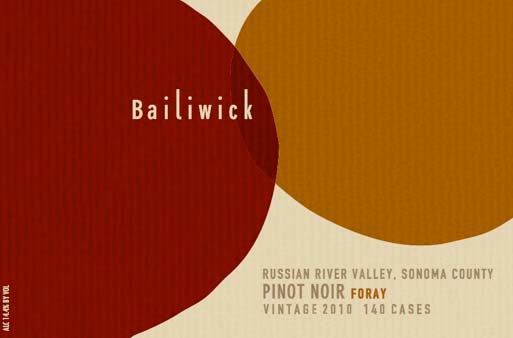 Bryan and Paul are natives of the San Francisco Bay Area who have been making wine in their home basements and various garages for 25 years while they pursued successful careers in engineering, technology and finance. In 2009 they launched a commercial venture, intent on producing premium Pinot Noir from specially chosen vineyards across multiple California appellations. The name they chose, Bailiwick, refers to a person’s special field of interest, authority or skill, in this case wine. The brothers come from a family of great cooks and are foodies themselves, and the wines they produce reflect that background in the suitability if their wines for the dinner table.
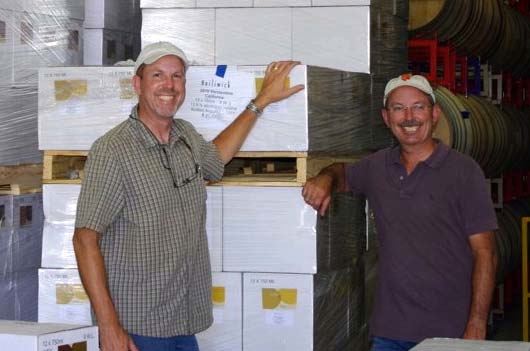 I recently sampled six new Pinot Noir releases from the challenging 2010 vintage and I am happy to report that these wines were even better than the previous vintage and superb across the entire lineup. This producer is no one trick pony. The AVA blends are released now and the single vineyard wines will be available in November. Two new wines were added in 2010: a Sonoma Coast AVA bottling and “Foray,” a single vineyard bottling representing a chance to get some extraordinary grapes under unusual circumstances. Paul told me the following. “2010 was a very difficult vintage, and we are doubly pleased that our wines turned out so well. We were well prepared for the September heat spikes and executed well to get grapes into the winery before they were ruined. In general, the fruit came in with reasonable levels of ripeness, acidity, etc.. Nonetheless, we managed to make six really nice pinots that we are proud to offer.” The photo below is of the entire work crew who look very happy.
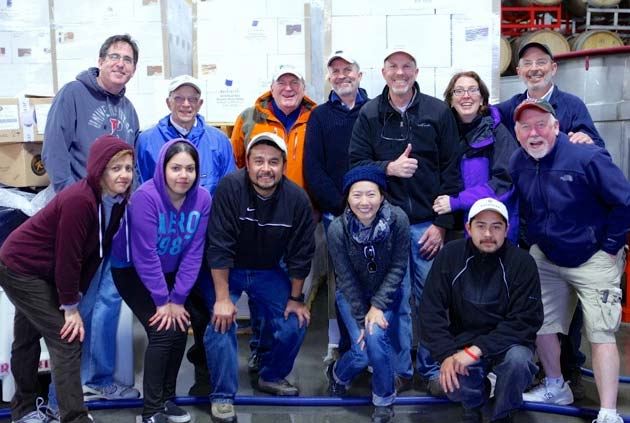 My general impressions of the wines were as follows. The aromatics are lagging the flavors at this early stage, which is to be expected, but they are still alluring. Each wine is distinctly different but there is a common thread of impeccable balance, admirable oak integration, and complimentary tannic structures, done in an elegant, gentle style: all you can ask for in California Pinot Noir. It is rare to have such a diverse portfolio of grape sources handled so adroitly. It was difficult for me to make discerning qualitative judgements as all the wines were excellent. The grapes for all wines were hand picked and sorted, 100% de-stemmed without crushing and fermented in open top containers. After a 3 to 4-day cold soak, commercial yeast was added to drive fermentation and highlight varietal aromas. Gentle punchdowns were performed three times a day. Post-fermentation maceration on the skins lasted several weeks. The wines were pressed off into French oak cooperage where they were aged for 17 months.
2010 Bailiwick Russian River Valley Pinot Noir 14.3% alc., pH 3.81, TA 0.62, 350 cases, $36. Drawn from three vineyards (41% Dutton-Lorenzo, 46% O’Neel, 13% RLR). Several clones including 115, 667, 777 and Pommard. Aged in 35% new French oak barrels. · Moderately light reddish-purple color in the glass. This is quintessential Russian River Valley Pinot dialed back in intensity: unplugged if you will. Initially shy aromas pick up intensity over the time in the glass offering scents of Bing cherries and baking spices. Delicious, deep cherry flavor on a silky framework in an intensely flavored, mid weight, elegant style, finishing with an appealing slinkiness. Silky tannins make for immediate accessibility. Very good.
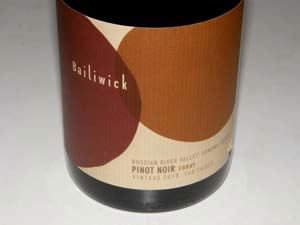 2010 Bailiwick Foray Russian River Valley Pinot Noir 14.4% alc., pH 3.66, TA 0.53, 140 cases, $40. From The RLR vineyard located just outside Forestville. Soil is Goldridge sandy loam and clones are 113, 114 and 115. Aged in 33% new French oak barrels. · Moderately light reddish-purple color in the glass. Shy aromas of earth-kissed black cherries, forest floor and deep red rose petals. Richer and more deeply flavored than the Russian River Valley bottling, endowed with a perfectly ripe core of sappy, dark red and black cherries and raspberries, supported by smooth oak and fruit tannins, and finishing with very impressive length. Still young and undeveloped, but displaying impeccable balance that predicts an optimistic future. Clearly special.
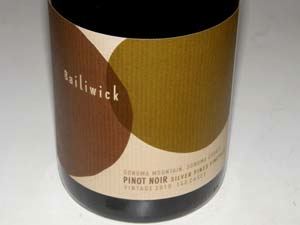 2010 Bailiwick Silver Pines Vineyard Sonoma Mountain Pinot Noir 14.2% alc., pH 3.66, TA 0.64,140 cases, $44. Growers are Norm and Carole Silverman. The vineyard overlooks Bennett Valley from an elevation of 900 feet. Planted in 2000, the loamy-clay volcanic soil is low in vigor limiting yields to about 2 tons per acre. Clone 115. Aged in 34% new French oak barrels. · Moderately light reddish-purple color in the glass. Nicely perfumed with aromas of dark red fruits, cardamom spice and candied rose petal. Juicy red cherries and berries saturate the mid palate, embellished with spice and magic. Healthy, but non-aggressive fine-grain tannins add grip and support. Still young and takes its own sweet time opening up. Tremendous finishing power with fruit coming and going in waves. Cellar this another year or two and you will be happily infatuated.
2010 Bailiwick Michaud Vineyard Chalone Monterey County Pinot Noir 14.9% alc., pH 3.66, TA 0.64, 120 cases, $44. This vineyard sits at 1600’ above the Salinas Valley floor at the entrance to the Pinnacles National Monument. Decomposed granite and limestone are at the surface. Farmed by Michael Michaud, a former winemaker for Chalone during its glory years. Clones 115, 667, 777 and Swan. Aged in 40% new French oak barrels. · Moderately light reddish-purple color in the glass. Delicate aromas of fresh blueberry-pomegranate juice and assorted dark fruits. Somewhat earthy, burly and rustic, displaying a hearty core of delicious purple and black fruits backed by ripe, firm tannins. A very elegant presentation that is unusual for this vineyard in my experience. Highly terroir-driven. Very good.
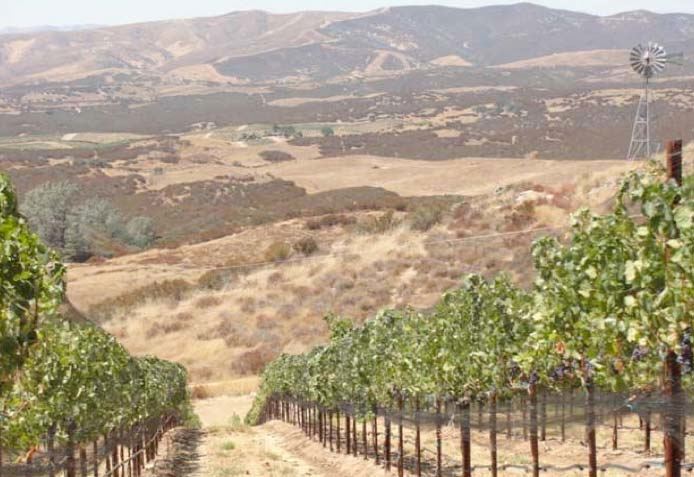
2010 Bailiwick Borderline Marin County Pinot Noir 14.4% alc., pH 3.69, TA 0.56, 100 cases, $36. Sourced solely from the Kendric Vineyard farmed by Stewart Johnson. Clones 115 and 777. Aged in 50% new French oak barrels. · Moderately light reddish-purple hue in the glass. A panoply of scents including black cherries, pie berries, clay, oak, and white chocolate that come and go in the glass. Strikingly fresh berry flavor, seemingly wild and exotic, underlain with well-integrated oak and supple tannins. Unusually ripe for cool Marin County. An evocative middleweight, that enters with aplomb, and finishes smooth and polished. I really like this Pinot.
2010 Bailiwick Sonoma Coast Pinot Noir 14.4% alc., pH 3.76, TA 0.64, 270 cases, $36. Sourced from the Ross Ranch Vineyard, located in the hills southwest of Sebastopol. Goldridge sandy loam soil. Clones 115 and Pommard. Aged in 50% new French oak barrels. · Light reddish-purple hue in the glass. Vibrant aromas of fresh red fruits, especially cherry glaze, with notes of spice, sandalwood and toasty oak. Explodes on the palate with melt in your mouth, perfectly ripe cherries accented by dark chocolate and spice. Very smoothly textured with gossamer tannins and noticeable persistence on the fruit-filled finish. Shows the most oak influence of all the Bailiwick wines this vintage, but it is not intrusive. Very good (+).
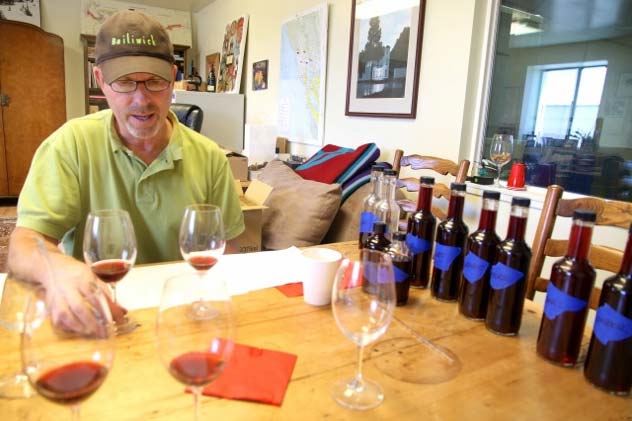 Visit the website at www.bailiwickwines.com to purchase wines online. A 2010 Cabernet Franc and 2011 Vermentino are also offered.
Cambria Estate WineryThis Kendall-Jackson property is located on the Santa Maria Valley Wine Trail and covers more than 1,400 acres. Barbara Banke, along with her spouse, the now-deceased Jess Jackson, established Cambria in 1986 after purchasing what was originally known as the Tepusquet Vineyards. This benchland is located between the Sierra Madre Mountains and the Sisquoc River, and was originally denoted as Tepuzli, a Chumash Indian term meaning “copper coin.” Spanish settlers later renamed it Rancho Tepusquet. The original owners of the rancho, part of a 1838 Mexican land grant, were the Olivera family who raised cattle and planted Mission grapes. According to Salud! The Rise of Santa Barabara’s Wine Industry (Victor Gurachi, 2004), Tepusquet Vineyards was owned by Luis and George Lucas and partner Al Gagnon, and consisted of a 2,700-acre ranch with 1,700 acres of developed vineyard dating to the 1970s. The Lucas brothers eventually fell on hard financial times and decided to sell the ranch. They spurned a generous offer from Beringer because of their concern that Beringer would “bury its quality grapes in their Napa Ridge second label and not give recognition to Santa Barbara County.” By 1985, Kendall-Jackson was producing 63,000 cases of Chardonnay per year from the Santa Barbara County region and Jess Jackson wanted to expand his production of Chardonnay to produce a vintner’s reserve based on Tepusquet Chardonnay grapes. Eventually, the Lucas brothers sold a sizable portion of the Tepusquet Vineyards to Jackson and Banke, who partnered with the Robert Mondavi Winery that valued the Tepusquet Vineyard’s Cabernet Sauvignon and Sauvignon Blanc grapes. Cambria Estate vineyards are located 17 miles inland from the Pacific Ocean and sit at 400 to 800 feet above sea level. They are planted in sandy, alluvial soil that is well-drained which limits yields and drives the vines to concentrate their energy on fruit maturation. The cool climate with moderating maritime influences from the east-west orientation of the valley leads to a long growing season and desirable acid retention. There are currently five estate vineyards at Cambria, with Katherine’s and Julia’s named after Banke’s daughters. Along with Tepusquet Vineyard, these three vineyards supply 90% of the grapes to the winery. A smaller contribution comes from Bench Break Vineyard and Rae’s Vineyard. The winery is best known for three wines: the Julia’s Pinot Noir, the Katherine’s Chardonnay and the Tepusquet Syrah. Julia’s Vineyard grapes are especially prized by local wineries and grapes have been sold to such notable wineries as Benjamin Silver Wines, Bonaccorsi, Byron, Foxen, Hitching Post, and Lane Tanner.
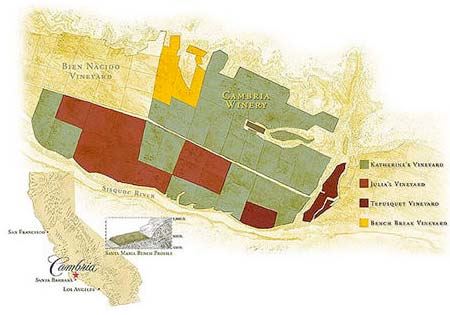 There are a total of 483 acres of Pinot Noir planted on the Estate including 4, 5, 12, 15, 23 2A, 115, 667, 777, 828, and Julia’s, creating an attractive mix of clonal diversity. Over 300 acres of the Estate are available for future development. All grapes from the Estate are certified sustainable by the CCSW program. The Julia’s Vineyard Pinot Noir is a standard bearer for Central Coast Pinot Noir. Anchored by one of the oldest commercial plantings of Pinot Noir in Santa Barbara County (1974), it contains eight different clones. It is produced in large enough quantities to be widely available in the retail marketplace and is value priced at about $25. What Steve Heimoff said in 2009 holds true today: “Julia’s Vineyard Pinot Noir is the best Pinot Noir at this price on the market.” What is less well known and advertised is that Cambria Estate Winery also specializes in limited production, distinct clonal Pinot Noirs. If you have the interest, tasting the clonal Pinot Noirs side-by-side can offer a good education in clonal differences since the wines are vinified in an identical manner. These wines are sold primarily through the winery’s tasting room, to wine club members, and to a mailing list, but you can call the winery at 888-339-9463 for availability. Denis Shurtleff was appointed winemaker in 2002. She is a graduate of Cal Poly San Luis Obispo who started her career as a lab technician at Corbett Canyon. She eventually worked her way up to winemaker and spent sixteen years at Corbett Canyon. She then joined winemaker Fred Holloway at Cambria and eventually replaced him. All Cambria wines are grown, produced and bottled on the Estate.
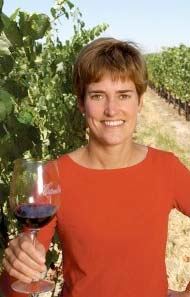 I recently sampled the 2010 Cambria releases of Pinot Noir. Denis noted that an unusually cool summer and fall prolonged the already long growing season in 2010 and harvest did not begin until the middle of September. A heat wave struck the Santa Maria Valley quickly ripening the rest of the Pinot Noir. The grape clusters and berries were small, resulting in rich and concentrated flavors with strong acid levels. The winemaking regimen for the single clone Pinot Noirs was as follows. The clusters were de-stemmed into half-ton picking bins. The must was shoveled into new French oak barrels that had one head removed, thus converting them into “open top” fermenters. The must was then cool soaked for a week and primary fermentation ensued in the barrels. The must was punched down by hand twice a day and then pressed off to dryness. Finally, the wine was returned to French oak barrels for 10 months of aging. The Cambria Estate Winery website is extremely informative and well-organized. Visit www.cambriawine.com. The tasting room on the Cambria Estate property is located at 5475 Chardonnay Lane in Santa Maria and is open daily from 10:00 to 5:00.
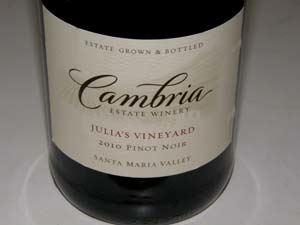 2010 Cambria Estate Winery Julia’s Vineyard Santa Maria Valley Pinot Noir 14.6% alc., pH 3.59, TA 0.54, $25. Clones 4, 2A, 23, 667, 115, 12, 5 and 777. Aged 8 months in 26% new French oak barrels. Week-long cold soak for optimum color and flavor extraction. · Moderately dark reddish-purple color in the glass. Beautifully perfumed with aromas of boysenberry pie glaze, dark cherries, black grapes, spice and just a hint of mocha. Very tasty core of moderately dark red, blue and black berries with an earthy undertone, well-integrated oak and a polished mouth feel. A quintessential Santa Maria Valley wine that has respectable power, good finishing length and enough spirit to be thoroughly satisfying. Very good.
2010 Cambria Estate Winery Clone 115 Santa Maria Valley Pinot Noir 13.8% alc., pH 3.48, TA 0.50, 261 cases, $52. Aged 10 months in 100% new French oak barrels. · Medium reddish-purple color in the glass. Subdued, but likable aromas of dark cherries, berries and spice. An appealing rush of dark red fruits saturates the entry, expands in the mouth, and finishes extremely long and powerful. Hints of herbs and edible flowers add interest. Lithe, with supple tannins and appealing crispness. Very good.
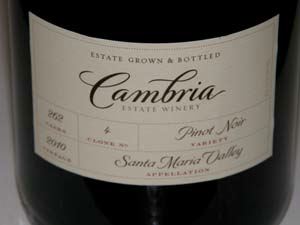 2010 Cambria Estate Winery Clone 4 Santa Maria Valley Pinot Noir 14.9% alc., pH 3.60, TA 0.57, 262 cases, $52. Aged 10 months in 100% new French oak barrels. · Moderately dark reddish-purple hue in the glass. A complex and alluring nose offers scents of black cherries, spice, wood shop, mushroom and sandalwood. Polished and very appealing with impeccable balance, offering flavors of fresh, spicy black cherries, with a hint of toasty oak in the background. Lavish, seductive and satiny, this is pure pleasure. Given a choice, I always seem to prefer single Pommard clone wines over single Dijon clone wines.
2010 Cambria Estate Winery Clone 667 Barbara’s Santa Maria Valley Pinot Noir 14.9% alc., pH 3.35, TA 0.65, $80. The winery’s pinnacle wine made from owner Barbara Banke’s favorite grape. Aged 10.5 months in 100% new French oak barrels. · Dark reddish-purple color in the glass. Very subdued aromas of black raspberries, aged wine cellar and oak. Rich, dense and deeply flavored with copious amounts of black raspberry and blackberry fruit and a riff of complimentary oak spice in the background. The lush fruit extract is somewhat buried in the structural tannins and the wine will need more time in the bottle to correct this. The finish is of special note with the dark fruited aromatics returning for several extended encores. This is a Cabernet drinker’s Pinot that is bit over the top for me, but is very well made in its style. Solid now, but may deserve more accolades in a few years. Good.
Neely: Santa Cruz Mountains Pinot Noir PersonifiedNeely is one of three labels produced by the Varner brothers that also includes Varner Estate and Foxglove wines. Bob and Jim Varner have produced superb Pinot Noir and Chardonnay from the Santa Cruz Mountains for years, but have largely been off the radar except to the most dedicated pinotphiles. Because the estate Spring Ridge Vineyard and winery are located in the Russian Ridge Open Space Preserve in the scenic grassland hills of Portola Valley, the winery cannot have a tasting room, accept visitors, or conduct events, and thus remains largely hidden from the public eye. Jim Varner is a graduate of the University of California at Davis and began his winemaking career in the Napa Valley. He longed for a cooler climatic region and found the current site in the Skyline sub-region of the Santa Cruz Mountains (12 miles east of the Pacific Ocean, 10 miles west of the San Francisco Bay and just west of Palo Alto). The property is situated within a large parcel owned by Dr. Kirk Neely and his wife Holly, and the Varners produce the Pinot Noirs under the doctor’s Neely label in much the same fashion as their own Varner Estate Pinot Noirs. Jim is pictured below at his winery when I visited in 2009.
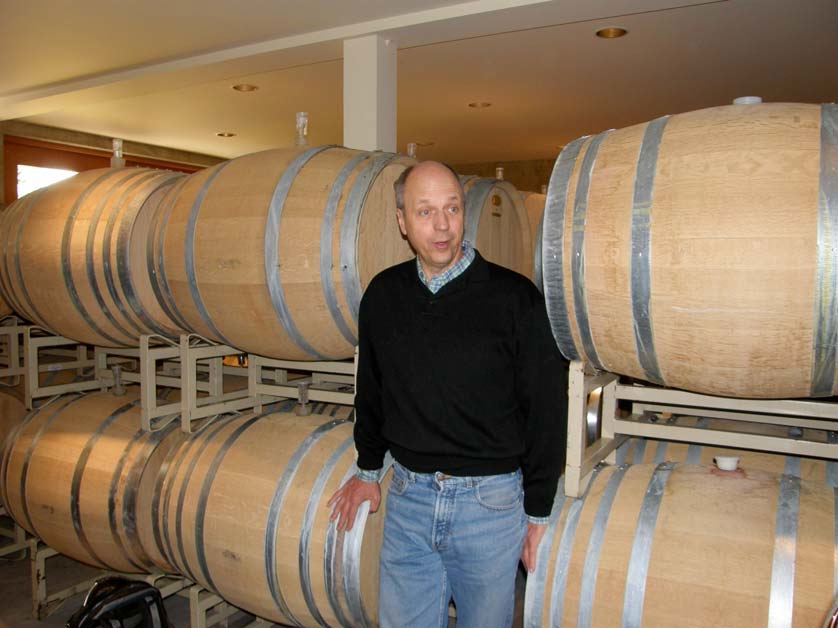 Jim’s brother, Bob, was studying genetics at the University of California at Berkeley when Jim invited him to see the property. He was immediately taken by the site and the pair began planting the Spring Ridge Vineyard in 1980. They started with Chardonnay and Gewürztraminer. In 1997, 7 acres of Pinot Noir were planted (clones 115 and 777), and in 2006, the Gewürztraminer was grafted over to Pinot Noir clone 777, effectively resulting in 25-year-old Pinot Noir vines. Bob eventually became the winemaker and Jim took over the sales and marketing of Varner wines. The Spring Ridge Vineyard is farmed organically with only sulfur employed to control mildew. Other disease pressure in controlled by canopy management. Several distinct blocks have been identified within the vineyard. For Chardonnay, there is the Home Block, the Amphitheater Block and the Bee Block. For Pinot Noir, there is the Hidden Block and Picnic Block. The block-designated Varner Hidden Block Pinot Noir (clone 115) is the signature bottling from the estate. The Spring Ridge Vineyard and Varner Winery are seen below in their very picturesque setting.

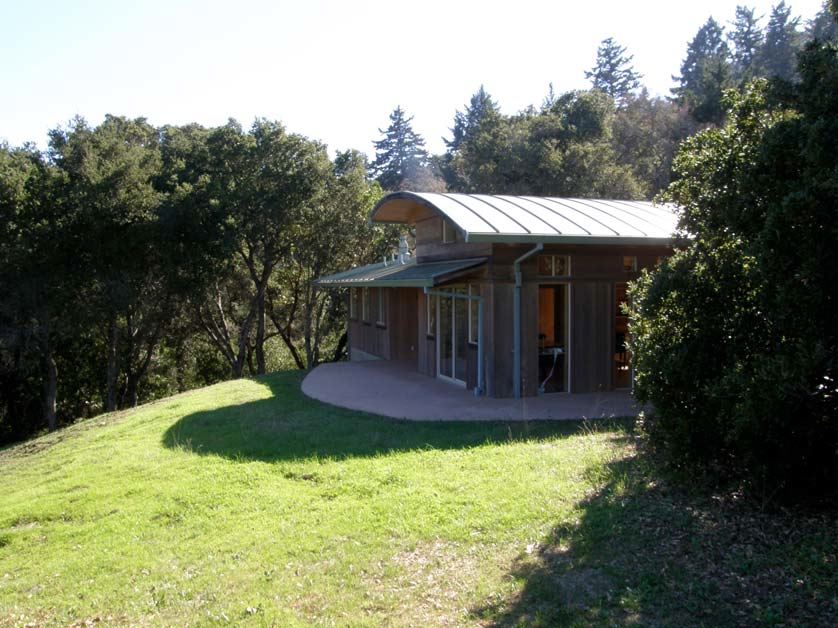 Both Neely and Varner Pinot Noirs are vinified with very little whole cluster, with indigenous fermentations, and are aged in 24% to 30% new French oak barrels from several cooperages. The wines are bottled unfined and unfiltered. One interesting note is that all the oak barrels have taps near the bottom to drain the wine instead of pumping it out through the bung on top. A special metal contraption made in France facilitates this.
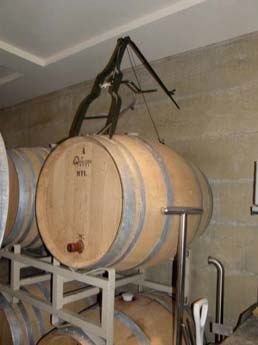 The three 2009 Neely block-designated Pinot Noirs are distinctly different but have a commonality of fresh middleweight flavors and good acidity. They vary in their fruit profile and intensity showing different expressions of the same vineyard. All wines can be enjoyed now but have the balance to age nicely. I could drink any one of these wines all night long. Neely and Varner wines are sold primarily through a mailing list with limited retail distribution. Visit the website at www.varnerwine.com to purchase wines (they are often sold out quickly to mailing list members). Neely wines have no website. The 2008 and 2009 vintage Neely wines are currently offered at www.klwines.com. The Varner Chardonnays are in the top echelon among California Chardonnays and are more readily available in the retail marketplace than the Varner Pinot Noirs. 650-321-4894.
2009 Neely Spring Ridge Vineyard Picnic Block Santa Cruz Mountains Pinot Noir 13.6% alc., $38. · Medium reddish-purple color in the glass. The nose is dark fruited and floral featuring fragrant scents of black cherries, dark berries and blueberries with a hint of violets and spice. Crisp and juicy with good depth of raspberry and cherry flavor that is nicely embellished with a touch of spice and toasty oak. The tannins are delicate and the texture is very silky. An elegant wine that finishes dry with a flourish of raspberry fruit. Very good.
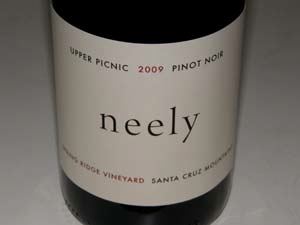 2009 Neely Spring Ridge Vineyard Upper Picnic Block Santa Cruz Mountains Pinot Noir 14.0% alc., $38. · Moderately light reddish-purple robe. The nose knocked me out. Deeply perfumed with fresh Bing cherries and hints of mocha and baking spices, in particular cinnamon. I kept coming back to the glass, the nose became better and better, and was indefatigable. Richly flavored cherry core, similar to the “iced cherry” often noted in Green Valley Pinots. More fruit-driven than the other two Pinots in this vintage but not in a bad way: cherry, cherry and more cherry. Refined, almost delicate, juicy and seamless, with complimentary oak driven accents of caramel and cola in the background. Tasted the following day from a previously opened and re-corked bottle, the wine was offering a striking display of strawberry and cherry fruit in an elegant format. This is a wine that is chock full of Pinot character.
2009 Neely Spring Ridge Vineyard Hidden Block Santa Cruz Mountains Pinot Noir 14.6% alc., $38. · Moderately light reddish-purple color in the glass. The nose veers to the very ripe and dark fruited side over time in the glass. Aromas of dark red pie berries and very ripe strawberries are noted. On the palate, the wine has power and richness, yet remains vivid and crisp like a splash of water from a mountain stream. Flavors of raspberries and plums are most evident with a hint of tutti-fruiti noted. The finish is quite fruity and persistent. Very good.
Rhys Vineyards: Tasting Recent Vintages is a RevelationThe number of wineries in the Santa Cruz Mountains is relatively small for such a large appellation, but the Pinot Noirs of a few producers are among the best in California. These wineries include Big Basin Vineyards, Mount Eden Vineyards, Rhys Vineyards, Thomas Fogarty, Varner and Neely, and Windy Oaks Estate Vineyards & Winery among those whose wines I have sampled recently. Owner Kevin Harvey of Rhys Vineyards currently has five diverse vineyards with distinct geological profiles in the Santa Cruz Mountains. Two of them, Family Farm Vineyard and Home Vineyard, are technically just outside the AVA but produce wines that are Santa Cruz Mountains in character. The other three vineyards are Alpine, Horseshoe Ranch, and Skyline. Most recently, Harvey has acquired an abandoned apple orchard on the southern end of the Santa Cruz Mountains chain near Corralitos where he plans to plant an additional 20 acres in 2013. Still another estate vineyard, Bearwallow, is located in the deep end of the Anderson Valley. The vineyards are described in detail on the winery’s website at www.rhysvineyards.com. All the vineyards meet important criteria: shallow soils which limit vigor, iron-rich soils, deeply fractured and rocky subsoils which allow vine roots to penetrate deeply, moderate clay content and limited water holding capacity, steep non-forested slopes, and a cool climate. Yields from these vineyards have typically been painfully low. The name, Rhys, is derived from the Welsh spelling of Reese. The first estate vineyard Pinot Noir release came in 2004, and the 2007 vintage was the first in which all five vineyards were in production. A second bottling from Alpine Vineyard is from a special block known as Swan Terrace, and is kept separate because of its distinctive character. Harvey has shunned the newer Dijon clones for the most part and instead planted “suitcase” selections such as Calera, Swan, La Tache, Hyde and Wente. Over time, vines have been identified that naturally produce
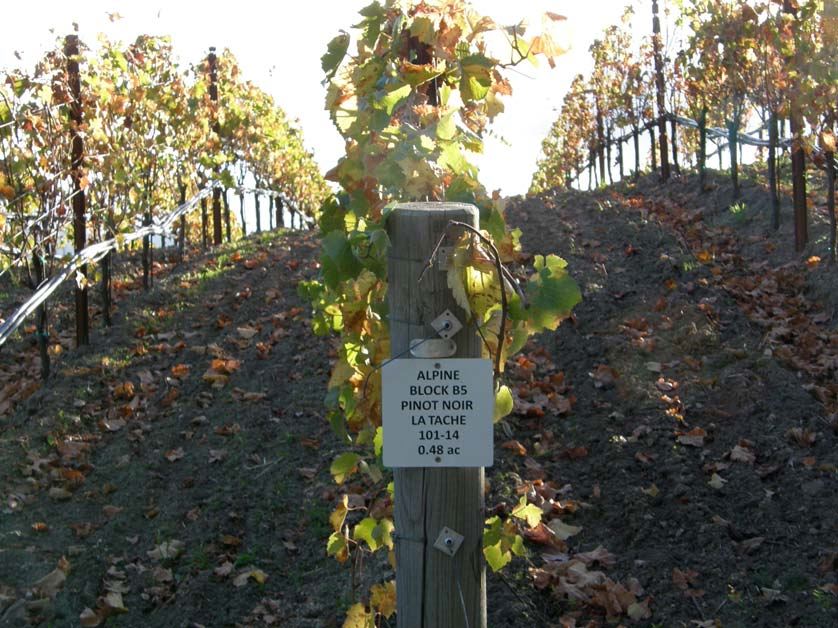 optimal quality at each of the vineyard sites. These vines offer a perfect balance of crop and canopy without excessive management and the wines that are produced from these vines have been carefully scrutinized. In some instances, the Rhys crew has determined that they then can achieve higher quality by regrafting some vines with cuttings from existing vines. The majority of the new grafts are a selection massale (mass selection) or mixture of clones that have been find optimal for a given vineyard. This is an extensive undertaking, but one that will steadily increase quality in the future.
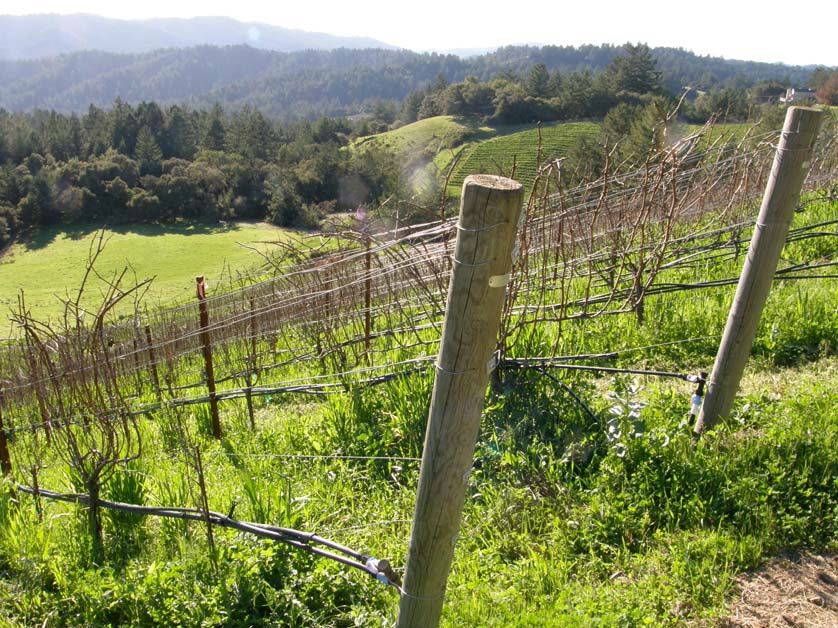 The young and talented winemaker at Rhys Vineyards is Jeff Brinkman. Brinkman majored in biochemistry in college, sold wine at the retail level for a short time, and then learned winemaking on the job, beginning as a cellar rat in 1996. Brinkman makes it clear that Rhys wines are made in the vineyard. In the winery, the grapes from each site are handled in an identical manner. Picking occurs early, often at 21.5º to 23º Brix. The grapes are harvested over a several day interval without concern about achieving the same ripeness in every vine row. Harvey notes, “A variety of ripeness makes a more interesting wine.” The grapes are carefully hand sorted, and placed 100% whole cluster into 1-ton fermentation tanks. Fermentations are carried out in small lots from specific vineyard blocks and reassembled in the blending process later. A 10 to 14-day cold soak under sealed conditions is followed by natural fermentation. The cap is punched down three times a day by foot treading. The wine is pressed off with a basket press and the juice gravity fed into oak barrels. Blending takes place either before or after the next harvest after the wine spends approximately 14 months in barrel. All barrels are sourced from Francois Frères and made from 4-year air-dried staves, eliminating any barrel variability effect on the finished wines. New oak percentage is variable and constantly being refined. The estate wines are unfined and unfiltered. The whole winemaking process is natural and straight forward and harkens back to the days in Burgundy when wine really was made in the vineyard. Rhys wines are highly allocated and sold only through a mailing list. Allocations are based on aggregate purchase history. The wines are very hard to come by and I often don’t receive a full allocation of every wine. The wines are released to mailing list customers in the spring and fall. Most wines are aged a full year in bottle before release. Rhys Chardonnays are exceptional as well. A second label, Alesia, offers less-expensive wines from regions outside the Santa Cruz Mountains and wines that do not fit into vineyard-designated bottlings. A 10,000-case winery ensconced in a cave at Skyline Vineyard was finished in 2010 and has hosted Open Houses for members of the mailing list on Pickup Days. Allen Meadows, Eric Asimov, Matt Kramer and many others, including myself, have been fans of these terroir-driven wines. Follow Rhys harvest and happenings at www.twitter.com/RhysVineyards. For the complete low down on Rhys Vineyards, read my feature from 2009 at www.princeofpinot.com/article/633/. I recently got the urge to pop some corks on recent vintages of Rhys Vineyards Pinot Noirs to see how the wines were progressing. Most of my tastings have been at the winery with barrel samples or recently bottled examples. This tasting was a revelation. The wines are low in alcohol, yet exhibit ripe fruit phenolics. They are all deeply colored with no intrusion of oak and nicely integrated acidity. All the wines change dramatically over time in the glass, and some have very impressive length. These are serious wines that benefit from cellaring and will continue to evolve over the coming years. It will be exciting to see what these wines are like ten years down the road compared to their Burgundy cousins. I suspect the fruit will fade and exhibit secondary characters, the now prominent tannins (of the 2007 and 2008 vintages) will change and integrate, while the bright acidity will hold the wines together, and the low alcohol levels should never intrude.
2009 Rhys Santa Cruz Mountains Pinot Noir 13.3% alc., $45. The inaugural Santa Cruz Mountain appellation Pinot Noir is a blend of barrels from Alpine and Horseshoe vineyards. As the vineyards mature and produce more wine with each vintage, more careful barrel selection is done to determine the final single vineyard wines, making this appellation bottling available. · Medium reddish-purple color in the glass. Outgoing aromas of dark berries, spice, redwood and campfire. Deliciously rich and intensely flavored core of black cherry, dark berry and blueberry fruits, exotically spiced with a hint of lemongrass. Very soft and easy to drink now. Less refined the following day from a previously opened and re-corked bottle, showing more oak. This is a solid daily drinker for current consumption. Good.
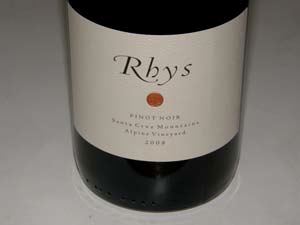 2008 Rhys Alpine Vineyard Santa Cruz Mountains Pinot Noir 13.3% alc., $59. · Moderately dark reddish-purple color in the glass. The aromas are clean and airy, smelling of a vast meadow of damp earth and brush, but also endowed with scents of ripe dark cherries and black raspberry syrup. I find this nose enchanting. On the palate, the wine offers a dark red fruit festival with a hint of baking spices showing more body, more finish and better integrated tannins than the 2007 vintage version. Very flavorful now but still young at heart.
2007 Rhys Alpine Vineyard Santa Cruz Mountains Pinot Noir 13.3% alc., $49. · Moderately dark reddish-purple color in the glass. Wonderful nose replete with bright aromas of black cherries, cherry pie, spice, vanilla, pipe smoke and an earthy goodness. Moderately rich basket of fresh black cherries wrapped in firm, slightly astringent tannins, filling the palate with flavor, finishing long and very dry. Much more interesting and expressive the following day from a previously opened and re-corked bottle. Patience will be rewarded. Very good (+).
2008 Rhys Alpine Vineyard Swan Terrace Santa Cruz Mountains Pinot Noir 13.0% alc., $59. · Medium reddish-purple color in the glass. Shy aromas of darker berries, briar and dark chocolate. Fresh, juicy and modestly rich, offering flavors of mixed blue and black berries backed by ripe, firm tannins. Still young, and a bit monotone now, the wine opens slowly and reluctantly in the glass. The finish, even now, is notable for its staying power. Slightly better the following day from a previously opened and re-corked bottle, showing a lighter character and more acidity than the 2007 vintage version. Very good.
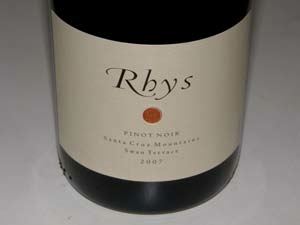 2007 Rhys Alpine Vineyard Swan Terrace Santa Cruz Mountains Pinot Noir 13.5% alc., $59. From a 1.5-acre section of Alpine Vineyard planted to a Swan field blend. · Moderately dark reddish-purple color in the glass. Another aromatic wonderland with scents of berry jam, spice, and an exotic floral note. Better and better over time in the glass. Would love to make a perfume like this. Amazingly fresh flavors of alpine strawberries with an interesting candied and edible flower note. I have never tasted anything quite like this in a California Pinot Noir. The wine displays healthy tannins, but they are better integrated in this wine and nicely balanced by the lively acidity. Filled with verve and intrigue, this is a wine to savor. Flat-out great the following day from a previously opened and re-corked bottle.
2008 Rhys Skyline Vineyard Santa Cruz Mountains Pinot Noir 12.2% alc., $69. · Moderately dark reddishpurple color in the glass. The nose is attention-getting with deep aromas of blackberries, sassafras, spice and old oak building in intensity over time in the glass. Blackberry and black plum flavors have interest but the wine is a bit tedious . Nicely crafted with notable but not intrusive tannins and the slightest oak in the background, but not enough Pinot singing on the finish. Slightly more expressive black fruits the following day from a previously opened and re-corked bottle. Check back in a few years. Good.
2007 Rhys Family Farm Vineyard San Mateo County Pinot Noir 13.4% alc., $49. · Moderately dark reddishpurple color in the glass. Shy aromas of dark cherries and berries with notes of oak char and anise. The nose never really opens until the following day. Lavish core of dark berry, black currant and black plum flavors with impressive density and lip-smacking sappiness. The wine has a very seamless quality and finishes on a high note with delicious tannin-backed dark raspberry flavor. Equally fine the following day from a previously opened and re-corked bottle. Very good (+).
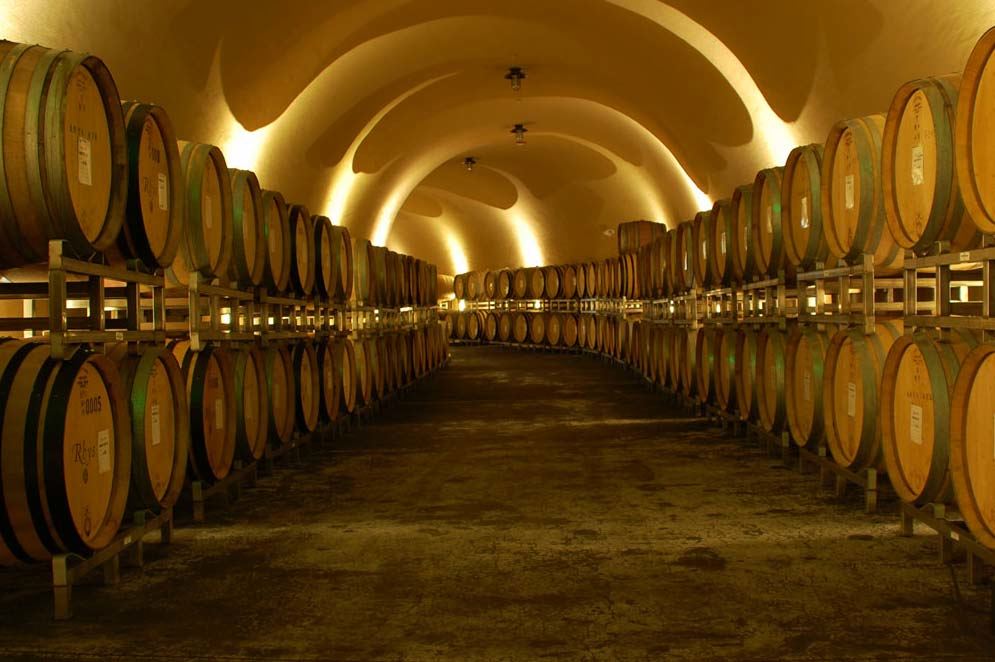
New California Releases from Evening Land VineyardsEvening Land Vineyards is an ambitious project, releasing Pinot Noir and Chardonnay from Seven Springs Vineyard in the Eola Hills of the Willamette Valley of Oregon, from vineyards in the true Sonoma Coast, Edna Valley and Sta. Rita Hills of California, and Bourgogne from Burgundy. Evening Land organically farms over 120 acres, producing 13 Estate wines. The vineyards contain a mix of old vine rooted Oregon and California heritage clones, cuttings from established vineyards in Burgundy and include an experimental block of Pinot Noir from seed. In Oregon, consulting winemaker Dominique Lafon works with winemaker Isabelle Meunier, and winemaker Sashi Moorman (photo below) leads his team in producing the wines from California. Moorman is a former chef got his start at The Ojai Vineyard. In 2012, UC Davis graduate Erin Miller joined Evening Land as the assistant winemaker at the Lompoc winery. He apprenticed in Burgundy and spent seven years working in the Sonoma Coast and Sta. Rita Hills before joining Evening Land full time. The Evening Land wines are divided into four groups, designated by the color of the label. The Blue Label wines in 2009 consist of an Oregon and California Pinot Noir, a California Chardonnay, and Etiole Bourgogne Rouge and Blanc from Burgundy. The Silver Label designates more focused wines including in 2009 a Sta. Rita Hills Pinot Noir, a Doc’s Ranch Sonoma Coast Pinot Noir, a Seven Springs Estate Pinot Noir, and an Auxey Duresses Chardonnay from Burgundy. The Gold Labels signify monopole estate wines from three vineyards in the Sta. Rita Hills, a Pinot Noir and Chardonnay named La Source from Seven Springs Vineyard, and a Beaune Bressandes Premier Cru Pinot Noir from Burgundy. The wines with White Labels are “pinnacle examples” of a vineyard and in 2009 consisted of an Occidental Vineyard Sonoma Coast Pinot Noir and a Seven Springs Vineyard Summum Chardonnay and Pinot Noir.
 The Evening Land Estate Vineyard in the Sta. Rita Hills provided four of the 2010 Pinot Noirs. Tempest, Memorious and Bloom's Field are all block selection wines from that vineyard. The 40-acre vineyard was planted on a previously untouched western edge of the appellation in 2007. The first vintage was 2009. The 2010 growing season was very cool with only one day breaking 80 degrees between bud break and harvest. The crop was light due to shatter and the desire not to push the young vines too hard. Harvest commenced during the first week of September and finished by the end of the second week. Chemistry was ideal with low sugars, low potential alcohols, excellent acidity and highly concentrated levels of ripe polyphenols. The wines showed intense colors and rich flavors. Whole clusters are included in fermentations in some cases and fermentations are indigenous. Pressing is gentle with a closed pneumatic press, with very little press wine going to barrel. A racking is done in the winter before bottling to emphasize an opulent mouth feel. After 12-14 months in French oak barrels, the wines were bottled without fining or filtering. New oak is less than 25% and in some cases, less than 10% of the total cooperage. All the 2010 wines reviewed here were well-crafted with deep color, dark fruits, moderate tannins, bright acidity, and a rich mouth feel. In some wines, the sheer volume of fruit flavor was impressive without over-extraction or jamminess. The Sta. Rita Hills Estate Vineyard wines are impressive considering it is only the second vintage from this vineyard. The only shortcoming of the wines was that there was not a whole lot to distinguish them from each other. A tasting room is open in the Lompoc Wine Ghetto Friday through Sunday from 11:00 AM to 5:00 PM. In Oregon, visit by appointment in Salem at 572 Patterson St. NW, St 170 (contact ib@elvwines.com). The wines are available through the Evening Land website at www.eveninglandvineyards.com.
2010 Evening Land Spanish Springs Edna Valley Pinot Noir 13.5% alc., 429 cases, $35, released summer 2012. 20% whole clusters. Vineyard is 2 miles from the Pacific Ocean sheltered behind the coastal range. The soils are diverse and well drained. Shorter fermentations and longer pressing with more of the press wine taken to barrel with the free run wine. New oak less than 25%. · Dark reddish-purple color in the glass. Nicely perfumed with scents of darker berries, plum, oak spice and violets. Middleweight, appealing flavors of blackberries, black currants, and sweet plums, engaged by supple tannins and bright acidity, with a slight oak undertone. Easy to drink with excellent balance and a seductively satiny mouth feel. Very good.
 2010 Evening Land Evening Land Estate Sta. Rita Hills Pinot Noir 13.0% alc., 652 cases, $45, released summer 2012. Vineyards planted with tight spacing using California heritage clones exclusively. Representative of diverse vineyard blocks. · Dark reddish-purple color in the glass. Aromas of black berries, black grapes, tea leaf, dried herbs and mushrooms. Exotic and savory with an enjoyable core of fresh dark berries and a soft note of citrus-flavored cranberries on the finish. The wine was significantly better the following day from a previously opened and re-corked bottle showing more expressive fruit and less savory aromas and flavors. Very good.
2010 Evening Land Evening Land Estate Tempest Sta. Rita Hills Pinot Noir 13.0% alc., 88 cases, $60, released summer 2012. A blend of Swan and Calera clones. From a warm part of the vineyard protected from the wind by a large rock outcropping to the west. · Dark reddish-purple hue in the glass. Terrific nose offering aromas of fresh, ripe black raspberries and blackberries with a hint of forest floor in the background. Moderately rich with lasting flavors of blackberries and black currants with a subtle herbal oak imprint. The fruit is pulled into line with firm, ripe tannins and wellintegrated acidity, and offers a flamboyant display on the finish. Even better the following day from a previously opened and re-corked bottle. Very good (+).
2010 Evening Land Evening Land Estate Bloom’s Field Sta. Rita Hills Pinot Noir 13.0% alc., 114 cases, $60, released summer 2012. From a cool vineyard block due to exposure to winds from the Pacific Ocean. The soil is clay loam and rich in iron. Because there were many shot berries, the clusters were de-stemmed. A long cold soak was employed and a slightly extended maceration at the end of fermentation enriched the tannins. New oak less than 10%. · Deep, dark reddish-purple color in the glass. Fairly nondescript nose with a hint of dark berries. Vibrant fruitiness with flavors of blackberries and boysenberries fanning out nicely on the palate and finishing with some strength and persistence. The wine is fresh and lively due to bright acidity but is burdened with considerable rustic tannins at this stage. It is a bit muddled and brooding, especially on the nose, and may benefit from more time in bottle although it tasted the same the following day from a previously opened bottle. Good.
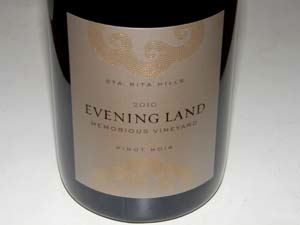 2010 Evening Land Evening Land Estate Memorious Sta. Rita Hills Pinot Noir 13.5% alc., 122 cases, $60, released summer 2012. Last part of vineyard to be harvested and the vineyard's most vigorous wine. The name comes from the seedling block that resides inside it. 7,000 seedlings planted, taken from Evening Land vineyards in Sonoma. Because these seedlings display the genetic diversity of Pinot Noir, they represent the "memory" of Pinot Noir. The fruit from these seedlings was not included in this wine. A little more new oak but less than 10%. Indigenous yeast fermentations. · Dark reddish-purple color in the glass. A generous array of purple and black fruit aromas with a complimentary hint of spice and oak, taking on more intensity over time in the glass. Very tasty blackberry core which enters with aplomb and expands in the mouth, filling every nook and cranny. A slight fresh citrus-driven acidity in the background gives the wine lift and a savory note adds interest. This one really grows on you over time. The following day when tasted from a previously opened and re-corked bottle, the evocative fruit had picked up intensity and the aromatics were still fresh and lively. This wine is a real attention-getter.
On the California Wine TrailA fine collection of Pinot Noirs (and a couple Chardonnays) were tasted recently. Special mention should be made of Scribe Winery in Sonoma Carneros. Recently featured in GQ Magazine, which called it “The Coolest Hundred Acres in Wine Country,” it has become amazingly popular among Bay Area food and wine cognoscenti in a relatively short time. The tasting room is outdoors on a knoll overlooking the vineyards with picnic tables strategically scattered about to take advantage of the view. Visitors reserve a table for 90 minutes where they can sit, chill and drink some great wine while receiving personalized but not obtrusive attention. Appointments are fully booked up to a month in advance. The biggest challenge for the owners, Andrew and Adam Mariani, is not selling wine but producing enough wine to sell. Scribe wines are on the wine list at all four San Francisco two-star Michelin restaurants: Atelier Crenn, Benu, COI and Saison, and eight Northern California restaurants that have received one star. Of the two restaurants receiving the highest Michelin rating of three stars, Meadowood pours Scribe Chardonnay. If you visit, please say hi to my son, Dane, who works for Scribe in multiple capacities, while still finding time to manage my PinotFile website on his days off. Visit www.princeofpinot.com/winery/1220/.
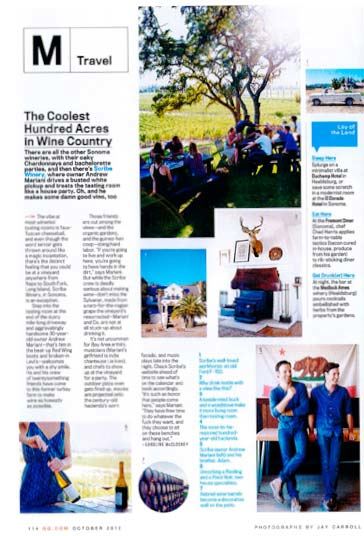
2011 Scribe Carneros Chardonnay 12.5% alc., 900 cases, $38. From a nearby vineyard farmed organically by owner who is Scribe’s vineyard manager. 80% Robert Young clone and 20% clone 76. Natural primary fermentation, no malolactic fermentation, slightly extended lees contact, 100% stainless steel (no oak). Light straw color in the glass. · Light straw color in the glass. Very fresh array of aromas that dance in and out including lemon, passion fruit, straw, nuts and vanilla cream. Crisp, clean and bright with flavors of lemon, white peach and a hint of banana brought into focus with uplifting acidity. A touch of minerality adds to the pleasure. A pleasing, food-friendly wine. Very good.
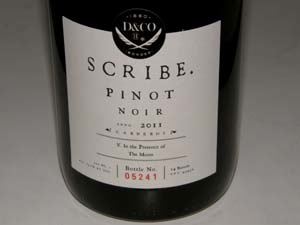 2011 Scribe Carneros Pinot Noir 13.1% alc., 350 cases, $42. Sourced from the bayside flatlands of Carneros. Yields 4 tons per acre. Wild yeast fermentation. Aged 5 months in neutral French oak. · Moderately light reddishpurple color in the glass. Very enticing aromas of black cherries, black raspberries, Middle Eastern spice, and a hint of tar and smoke. The mid-weight flavors echo the nose, supported by gossamer tannins and good acidity, and showing very gentle oak highlights. Highly enjoyable and easy to drink, the refreshing cherry-driven finish urges you to take another sip. This is Pinot Noir unplugged and offers what many Pinot lovers crave: wonderful, soft, highly approachable fruit flavors linked with a relatively low alcohol percentage. Even better when accompanied by food. Tasted twice. Very good.
2011 Crossbarn by Paul Hobbs Sonoma Coast Chardonnay 14.1% alc., 3,000 cases, $25, screw cap. · Light straw color in the glass. Fresh aromas of lemon, pear, banana peel, vanilla, roasted nuts and sea shells. Slightly creamy on the palate with appealing flavors of lemon pudding, peach skin, and tropical fruits with a slight nuttiness in the background. A solid wine with reasonable vibrancy and a smooth finish. Good.
2011 Crossbarn by Paul Hobbs Sonoma Coast Pinot Noir 14.5% alc., 4,000 cases, $35, screw cap. · Moderately dark reddish-purple color in the glass. Scents of darker berries, rhubarb and forest floor lead to flavors of black cherries, blackberries and a sidecar of herbs and oak. Nothing special, but enough richness to satisfy, and styled with soft tannins for easy drinking. Decent.
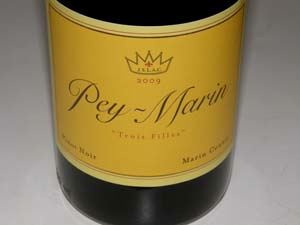 2009 Pey-Marin “Trois-Filles” Marin County Pinot Noir 14.0% alc., pH 3.57, TA 0.65, 345 cases, $39. A loving tribute to the Peys who have three daughters (“trois-filles”). From three sites located less than 8 miles from the Pacific Ocean. Low yielding vines, trademark tiny clusters and berries and high natural acidity. Multiple Dijon clones and heritage selections. 100% de-stemmed, native fermentation initially with Burgundian yeast inoculation subsequently. Aged 14 months in 3-year air-dried French oak cooperage with extensive sur lie stirring. Unfined and unfiltered and aged in bottle for 10 months. · Moderately deep reddish-purple color in the glass. The nose is dominated by aromas of dark red fruits with underlying notes of clay, oak and dark red rose petals. Well-endowed with middleweight flavors of pie filling fruits including raspberries and strawberries backed by mild, dry tannins and a refreshing cut of acidity. The wine is soft and smooth in texture, showing admirable integration of oak, and exhibiting impeccable balance. Picks up intensity and adds a peppery herb and spicy twist to the lengthy finish the following day from a previously opened and re-corked bottle. Would definitely benefit from decanting if you drink now.
2010 Kutch Sonoma Coast Pinot Noir 13.9% alc., 240 cases, $39. Sourced from three vineyards. 100% de-stemmed, native yeast fermentations, aged 16 months in 33% new French oak barrels. · Moderately light reddish-purple color in the glass. The nose is rather shy and nondescript, offering demure aromas of cherries. Moderately rich essence of dark red cherries and berries with complimentary oak, offering supple tannins, good acidity and a short, but pleasing finish. This wine is refined and balanced, and I would be content to drink it, but it doesn’t emote. Good.
2010 Kutch Savoy Vineyard Anderson Valley Pinot Noir 13.45% alc., 240 cases, $50. 100% de-stemmed, native fermentations, aged 16 months in neutral oak. · Moderately light reddish-purple color in the glass. Well-endowed with aromas of black cherries, black raspberries and baking spices. Elegant and charming with soft tannins, offering flavors of dark red Pinot fruits with a hint of spice, finishing with some crisp length. Highly approachable now, it may pick up more nuance over time. A more delicate Savoy in this vintage. I miss a little touch of new oak, but this is done well in its style. Very good.
2010 Sequana Russian River Valley Pinot Noir 13.6% alc., TA 0.57, 2,597 cases, $38. Sourced from Sundawg Ridge, Dutton Ranch and Lakeview vineyards in the Green Valley of Russian River Valley. Pommard and Dijon clone 115. Aged sur lie 11 months in 40% new French oak barrels. · Moderately dark reddish-purple color in the glass. An array of aromas rise from the glass including black cherries, rose petals, wood box and a hint of citrus. Medium weight flavors of black cherries, cola and spice with the slightest hint of oak. Definitely Russian River Valley in character but a bit lean and ordinary. Decent.
2010 Sequana Santa Lucia Highlands Pinot Noir 14.1% alc., pH 3.96, TA 0.60, 5,952 cases, $32. From two 10-year-old blocks of the Sarmento Vineyard each planted to a distinctive clone: 50% 667 and 50% Pommard. Aged 9 months sur lie in 40% new French oak cooperage. · Moderate reddish-purple color in the glass. The nose is heavily oak-driven with a prominent scent of mocha java, and demure aromas of dark stone fruits and floral bouquet. Very fruity and pleasant to drink with flavors of black raspberries, black cherries, grilled mushrooms and black olives with a hint of candied rose. On the lighter side for a Santa Lucia Highlands bottling, with very silky tannins making it very user-friendly. Good.
2010 MacPhail Gap’s Crown Vineyard Sonoma Coast Pinot Noir 14.0% alc., TA 0.60, 775 cases, $49. Released fall 2012. Clones 115, 667, 777. 100% de-stemmed, 5-day cold soak, indigenous yeast fermentations, weekly lees stirring for 3 months, aged 11 months in 60% new and 40% once and twice used French oak barrels. Unfined and unfiltered. · Dark reddish-purple color in the glass. Delicate perfume of fresh black cherries with a hint of nutty oak. Delicious core of black cherry and black raspberry flavors that deliver a stunning mid palate impression. Seamless, with mild supportive tannins and a lengthy, fruit-scented finish. I wished for more aromatically from this wine, but this may come in time. Meanwhile, the flamboyant fruit flavors will bring you to your knees. Very good.
2010 MacPhail Sangiacomo Vineyard Sonoma Coast Pinot Noir 13.9% alc., TA 0.57, 275 cases, $49. Released fall 2012. 50% Dijon 115 and 50% Pommard. Sourced from a vineyard located off Roberts Road in the Petaluma Gap. 100% de-stemmed, 5-day cold soak, native fermentations, weekly lees stirring for 3 months, aged 11 months in 50% new and 50% 1 and 2-year-old French oak barrels. · Moderate reddish-purple color in the glass. The aroma of coffee-scented oak dominates the nose with little fruit evident. Perfectly ripe, vivid dark red fruit smothered in oak. Soft and smooth on the palate with gossamer fruit tannins and a refreshing finish. The oak will surely integrate better over time, but I fear this will always be an oaky wine. Decent.
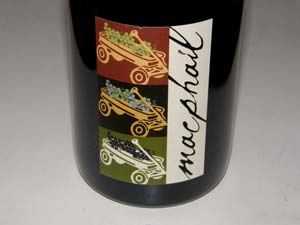 2010 MacPhail Wildcat Vineyard Sonoma Coast Pinot Noir 14.9% alc., TA 0.55, 250 cases, $49. Pommard, 115, 667 and 777 clones. 100% de-stemmed, 5-day cold soak, indigenous fermentations, weekly lees stirring for 3 months, aged 11 months in 60% new and 40% 1 and 2-year-old French oak barrels. Unfined and unfiltered. · Moderately light reddish-purple color in the glass. Demure aromas of pie cherries, forest floor, underbrush and nutty oak. Displaying admirable finesse with powerful dark red fruit flavors, this is a classy wine that is really delicious. The tannins are supportive and the oak is well integrated and complimentary. A nicely crafted wine from a very prestigious vineyard that has produced consistently great Pinot Noirs. Very good.
2010 Red Car Heaven & Earth Bohemian Station Sonoma Coast Pinot Noir 13.6% alc., $60. A 4.5 acre vineyard formerly known as La Boheme in Occidental supplies the fruit. Planted in 2004 to Calera, Pommard and 828. Average yields are less than 2.5 tons per acre. · Medium reddish-purple color in the glass. Exotic nose of wild purple berries, Middle Eastern spices, with a little stem and floral bent. Deep, dark moderately dense dark berry and Hoisin flavor with a savory note of herbs in the background. Definitely earth bound with typical sinewy Sonoma Coast tannins. Good (+).
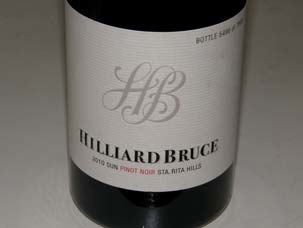 2010 Hilliard Bruce Sun Sta. Rita Hills Pinot Noir 14.9% alc., 600 cases, $55. Can’t get Paul Lato Wines? Try Hilliard Bruce where Paul is the consulting winemaker. The wines are not identical to Paul’s but his imprint is evident. Hilliard Bruce planted 21 acres of Pinot Noir and Chardonnay on 101 acres starting in 2004. The vineyards are Certified Sustainable and are located off highway 246 near Clos Pepe and directly across 246 from Dos Hermanas Vineyard (formerly Ashley’s). Aged in 50% new French oak barrels for 16 months. · This wine is beautifully composed offering enticing aromas of ripe black cherries, dark berries and cardamom spice, and luscious flavors of the same fruits with added notes of plum, cola and vanilla. Moderately rich with tannins that threaten to take over now but tend to mellow over time in the glass. The silky texture is very seductive. This wine is still a bit closed and will benefit from a few more years in the cellar. Very good.
2005 Native9 Rancho Ontiveros Vineyard Santa Maria Valley Pinot Noir 14.0% alc., $NA. Rancho Ontiveros overlooks Rancho Tepusquet, the third land grant the James Ontiveros family settled over 130 years ago. Father Mark and James Ontiveros tend the vines. · Dark reddish-purple color in the glass. Secondary bouquet of underbrush, cinder box, old book, cigar and sherry. Bold, very ripe, sweet dark plum and blackberry flavors losing out to dominant fine-grain tannins. A bit of acid shows up on the slightly tart finish. A well-aged wine that should be drunk now.
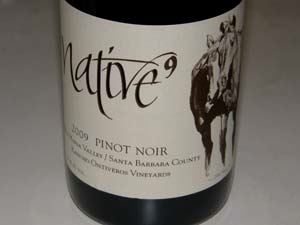 2009 Native9 Rancho Ontiveros Vineyard Santa Maria Valley Pinot Noir 14.5% alc., $60. This 8-acre vineyard was hand planted by James Ontiveros and named after the generations that came before him. His plantings were done between 1997 and 2000 (variety of clones and rootstocks). James is the Director of Sales and Marketing for the Miller family properties including Bien Nacido Vineyard. The winemaker is Paul Wilkins. I don’t know the proportion in this wine, but I know James uses a very high percentage of whole cluster. · Moderately light reddish-purple color in the glass. Aromas of dark red berries, spice, herbs and mocha jump out of the glass. Easy going and flat-out delicious, boasting a powerful core of deep red cherry and berry fruit sheathed in healthy, ripe tannins, but retaining admirable finesse. Remarkable staying power on the aromatic finish. This wine makes quite an impression. Approachable now, but should easily last another 7 to 10 years.
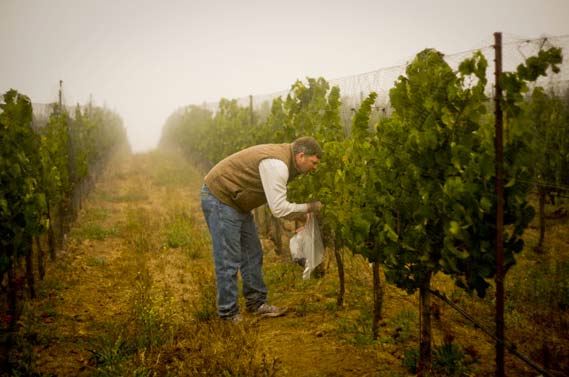
2010 Lucia Santa Lucia Highlands Chardonnay 14.1% alc., $40. Sourced from three small blocks at Pisoni Vineyards and vinified by Jeff Pisoni. Few wine connoisseurs are aware of the tiny amount of Chardonnay on the Pisoni property that was originally planted in 1982. · Light straw color in the glass. Aromas and flavors of baked pear, crème brûlée, pineapple and lemony citrus. A moderately rich style made with full malolactic barrel fermentation and barrel aging sur lie. Fresh, satisfying and thoroughly user friendly, displaying perfect integration of oak and overall impeccable balance. One of my favorite California Chardonnays and a great value.
50 Reasons Why Matt Kramer is WrongMatt Kramer is a highly quotable, well-respected wine writer best known for his monthly column in the Wine Spectator and several reference books on wine (New California Wine, Making Sense of Burgundy, and Making Sense of Wine). His quip, “Pinot is the voice of God,” will be forever enshrined in the pantheon of great wine quotes. Kramer has been contributing regularly to Wine Spectator since 1985, using his one-page commentary to “stir the pot” about subjects of interest to wine connoisseurs. His online “blog,” Drinking out Loud, invites lively online discussions at www.winespectator.com/kramer, where everyone may read his postings, but only paid members can respond with comments. His subjects are far-ranging, recently including “Why Today’s Wine Lists Need Radical Change,” and “The Big Lie of Wine Democracy.” I read Kramer’s acerbic observations online dated October 2, 2012, titled, “Dubious Wine Achievements of Our Time: How Smart Wine People Became Boneheads.” One particular subject caught my eye, “The Banalization of Russian River Valley Pinot Noir.” The word “banalization,” which Kramer created and may soon become part of wine lexicon, is rather derogatory, since banal means humdrum, unoriginal, uninspired and bourgeois. He said, “An awful lot of Russian River Valley Pinot Noir is repetitive; too many of the Pinots are, to this taster anyway, oversimple and overripe....Today, when I pick up a Russian River Valley Pinot Noir I brace myself for a deeply colored, lush, rather flat, simple wine with too much oak and too little of the layers and nuance that I, anyway, think distinguishes fine Pinot Noir.” He goes on to put the blame on late picking and the overuse of “flavor-potent” Dijon clones. Not so fast Kramer, your proclamation is far too general to be true. I could not respond online since I am not a dues-paying follower, so I am reacting through my personal newsletter with my corkscrew raised in defiance. There are definitely some examples of the banal type of Russian River Valley Pinot Noir Kramer refers to. Heck, I can give you examples from every major Pinot Noir producing wine region in California and Oregon. Yes, there has been a trend over the recent two decades to pick late, over oak, and produce Pinot Noir exclusively from Dijon clones, and this has been well-chronicled. It is also well known that at least some of this trend has been driven by the preferences of some prominent wine writers and the American palate. It is also true that the three Russian River Valley wineries Kramer admires, Dehlinger, Rochioli, and Williams Selyem, are largely “Dijon-free,” but these producers, whose wines I also enjoy, might be slotted by some in the deeply colored, lush camp (post-Burt Williams in the case of Williams Selyem). It’s what Russian River Valley terroir can give you. Kramer admits in a more recent post, “Appellation matters....if a wine is presented to us as being distinctive precisely because of place, then we would feel hoodwinked upon learning differently.” Kramer you need to get out more and taste the variety of wines from the Russian River Valley. Here are 50 reasons why you are wrong. I have tasted multiple wines from several vintages for all the wineries listed. This is not an all-inclusive list but includes wineries crafting Russian River Valley Pinot Noir that exemplify my point. These producers offer wines that are anything but banal. Elegant in personality with tasteful use of oak, displaying nuanced aromas and flavors at modest extraction levels, with good supportive acidity, and often relatively low alcohol levels, these are wines to cherish. The noted winemaker of Alysian Pinot Noir from the Russian River Valley, Gary Farrell, has eloquently expressed the goal of a predominant number of current Russian River Valley vintners. “Many consumers and winemakers are beginning to favor a more elegant and refined style of wine. It is not that we seek less flavor, texture or depth; it’s simply that we understand abundance and generosity in wine is achievable without excessive extract and alcohol.” It is important to emphasize that there are multiple terroirs in the vastness of the Russian River Valley that encompasses 126,000 acres. Wines from these diverse areas exhibit significant differences. Wines of the type Kramer refers to as banal, are more often from the warmer and less fog-influenced northerly regions of the Russian River Valley and the area east of Highway 101. The wines from the very cool Green Valley appellation, which is wholly contained within the Russian River Valley and is referred to as Green Valley of Russian River Valley, for example, are completely different. They are usually labeled as from the Russian River Valley. Green Valley Pinot Noirs typically have lively acidity that is termed “ice cherries.” The wines are closer in type to the Sonoma Coast than the Russian River Valley with bright, crisp, and nuanced fruit flavors. No true wine lover would call these authentic wines banal. Kramer has offered a negative, far-reaching, and inaccurate generalization which to me serves little purpose, demonizes Pinot Noir, and unfairly stereotypes a particular wine region. A preferable course would be to embrace Pinot Noir in all its myriad styles. For me, I like to quote Mick Jagger: “It’s only Pinot Noir, but I like it!”
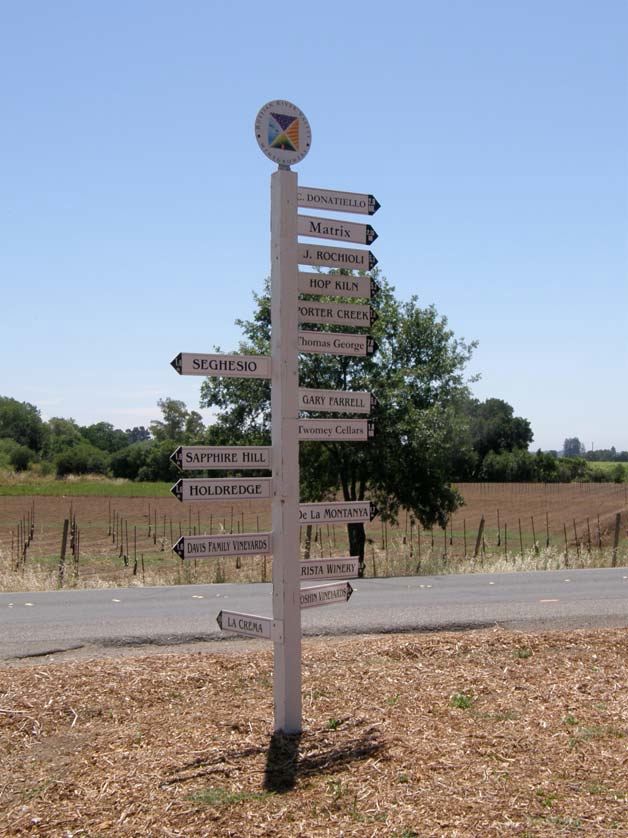
Alysian
2012 Sonoma County Harvest Fair Professional Wine CompetitionHere are the significant Pinot Noir medal winners in this annual highly respected wine competition. Best of Class & Gold Medal
Up to $24
$25 - $34.99
$35 and over
Gold Medal
Up to $24
$25 - $34.99
$35 and over
Pinot BriefsPinot Geek and Golden Geek Get Makeover The PinotFile is a unique wine publication in that numerical scoring is not used in reviewing wines. Short, relevant tasting descriptions are featured instead, intended to guide the reader to styles of Pinot Noir and Chardonnay he or she might enjoy. I prefer that the reader focus more on producers than specific wines. That said, I do provide a qualitative assessment at the end of each tasting note which includes the categories of Exceptional (represented by the Pinot Geek or Golden Geek Icon, and indicating a complete and transcendent wine), Very Good (a distinctive and beautifully crafted wine), Good (a solid wine of varietal character), Decent (an undistinguished but drinkable wine), and Unsatisfactory (a wine that is flawed or one that I would not recommend). The Pinot Geek Icon was originally intended to represent a passionate pinotphile who had sampled so much Pinot Noir his lips and teeth were stained reddish-purple. The image was taken from a photo of my oldest son, Garrick, who has very prominent lips and a big smile. He is gregarious, upbeat, good-humored and likable. He enjoys great Pinot too. Influenced by some opinions I have received over the years, I decided to refine and humanize the caricature and discard the purple lips and teeth. Thanks are due Wendy Coy of Coy Design in Sebastopol (www.coydesign.com), and my other son, Dane, for their contributions to the redesign. Here are the new icons:

Russian River Valley Film Maurice (Joe) Nugent, founder of Nugent Vineyard in the Russian River Valley, has finished a film on the Russian River Valley titled “From Obscurity to Excellence: The Story of Grapes and Wine in the Russian River Valley.” A preview of the film is available at www.russian-rivervalley. com/. The movie will premier in the tasting room at Rochioli on Friday, October 26, 2012, for wineries, news people and theater representatives. Future showings are planned. Follow Nugent’s blog at www.rrvmovie.wordpress.com/. Oregon: I’ll Bet You Didn’t Know After California, Oregon is one of the three top wine-producing states, along with Washington and New York. Oregon wineries received 1.5 million visitors last year and about half of these were from out of state. The Allison Inn, located in Newberg in the Willamette Valley, was named by Travel + Leisure magazine as the top resort spa in the continental United States for 2012. There were 20,400 acres of planted vineyards in Oregon in 2011, over half of it Pinot Noir (12,560 acres), followed by Pinot Gris, Chardonnay and more than 60 other varieties. The Willamette Valley is the largest Oregon AVA, consisting of 5,200 square miles and is named for the river that bisects the Valley for most of its 150 miles length. Two-thirds of Oregon’s wineries are located in the Willamette Valley. The tiny town of Carlton, situated in the northern Willamette Valley, was once a sawmill town, but is now home to 40 winemakers. Tasting Room Opens at Fort Ross The first tasting room in the new Fort Ross-Seaview appellation near Jenner has been opened by Fort Ross Vineyard. Fort Ross Vineyard is among the closest vineyards to the Pacific Ocean in California. The Fort Ross-Seaview appellation, approved by the U.S. Trade & Tax Bureau January 13, 2012, is the first of what may be more subdivisions of the huge Sonoma Coast appellation. It covers the first two coastal ridges and west-facing slope of the third ridge line and extends over 27,500 acres. Prominent Pinot Noir producers from the appellation include Fort Ross Vineyard, Flowers Vineyard & Winery, Hirsch Vineyards, Wild Hog, Marcassin, Failla, Pahlmeyer, Martinelli and Peter Michael. As of 2005, there were 46 commercial vineyards on about 1,400 acres. A photo of Fort Ross Vineyard is below. The tasting room, which offers panoramic views of the Pacific Ocean, is open 10:00-6:00 daily but hours vary seasonally so best to call ahead. Visit www.fortrossvineyard.com.
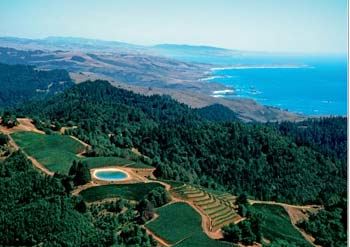 French Wine Regions Maps An online map of the appellations, vineyards and domaines in France is available at www.aocmaps.com. Disheartening News for Those with Wine Lockers In Irvine, California, George Osumi, who operated Legend Cellars, Inc., was charged with second degree commercial burglary, grand theft, and embezzlement after stealing nearly $3 million in vintage wines from storage lockers rented by clients. Apparently, Osumi broke into the private storage lockers of three different owners beginning in 2008, and switched bottles of valuable wine for cheaper bottles of wine. He then auctioned some of the stolen wine bottles and deposited the earnings into his business account. Fortunately I have my wine stored in a nearby facility in Irvine, the Wine Cellar Club Inc., where I have complete faith in the owners. Mornington Peninsula International Pinot Noir Festival The sixth MPIPNC will be held February 8-9, 2013 at RACV Cape Schanck Resort in the Mornington Peninsula, Australia’s most notable Pinot Noir growing region. The theme will be the pilgrimage of Pinot Noir and how far Australia has taken it from its 25 homeland. Featured speakers include Josh Jensen (Calera Wine Co.), Ted Lemon (Littorai), and Marquis Sauvage (Burn Cottage). The keynote speaker will be Jasper Morris MW. MPIPNC is modeled after the International Pinot Noir Festival in Oregon and is held every two years. For information and tickets, visit www.mpva.com.au. Monumental U.S. 2012 Harvest While the French harvest in 2012 is reportedly the smallest on record since 1991 and Italy and Spain will have record-low yields, California and Oregon are experiencing a banner year, the beneficiaries of perfect growing seasons and one of the driest seasons on record. Oregon’s harvest will not meet the record 41,500 tons of 2011, but the vintage is already being compared to 2002 and 2008, both of which were superb vintages for Oregon. Jesse Lange, winemaker at Lange Estate Winery and Vineyards in Dundee, Oregon, which is celebrating it’s 25th anniversary, has used the words “epic” and “spectacular” to describe the 2012 vintage harvest. Don Lange, inspecting grapes, is pictured below. In California, the crop looks to be significantly above average, especially for Pinot Noir and Chardonnay.
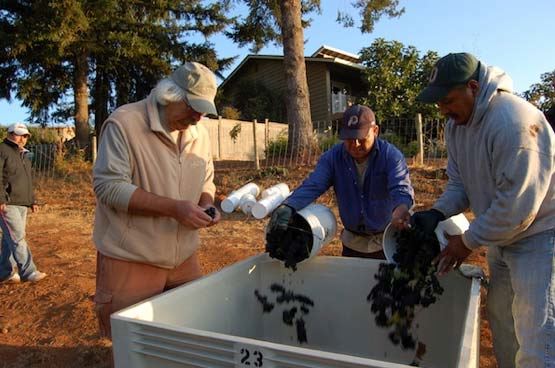 Williams Selyem Shows Up in Retail Marketplace It is certainly not publicized, but high end Pinot Noir producers may be struggling with sales and some are releasing their grasp on exclusivity. Los Angeles Wine Co. (www.lawineco.com) sent out an online offering on October 20 of 2010 Williams Selyem Bucher Vineyard, Eastside Road Neighbors, Flax Vineyard, Ferrington Vineyard and Estate Vineyard Pinot Noirs, (at full retail prices). I have also seen the Williams Selyem Sonoma County bottling in the bins at Total Wine. New Wines & Vines Directory & Buyer’s Guide The 2013 compendium of wineries in North America is now available for ordering at $95 at www.winesandvines.com. There are 7,600 winery listings, including 3,497 wineries in California, as well as custom crush facilities, suppliers, growers, and compliance information for all 50 states. The winery profiles include size, sales, and staff contacts. Oregon Wine History Project™ at Linfield College The Portland Tribune and Forest Grove News-Times recently paid tribute to the Oregon Wine History Archive at Linfield College. The Archive now includes a 1974 bottle of Dick Erath’s early Pinot Noir, and 80 linear feet of papers, maps and photographs detailing the work of Dick Erath, David and Diana Lett, Myron Redford, David Adelsheim, Bill and Susan Sokol- Blosser, and Dick and Nancy Ponzi. The Archive is tended by full-time archivist Rachael Woody and a number of Linfield College students. The material that can be digitalized is available at www.linfield.edu. New Study Questions Alcohol and Breast Cancer Link The Nurses’ Health Study (NHS) published last year found that even light and moderate alcohol consumption could increase the risk of breast cancer in women by 10 percent. Unfortunately, many well known publications warned women to abstain from alcohol if they have a family history of breast cancer. This month, the National Institute on Alcohol Abuse and Alcoholism (NIAAA) released a paper that questioned the epidemiological NHS study and recommended further study of the relationship between alcohol intake and breast cancer risk in women. The authors of the NIAAA study note that a significant problem with alcohol and breast cancer studies is that people tend to report less alcohol than they actually consume and resultant studies can overestimate the effect of a given amount of alcohol on breast cancer risk. Studies often lack information on drinking patterns as well. Phillip J. Brooks, Ph.D., program officer in the NIAAA Division of Metabolism and Health Effects emphasized the following. “In view of our lack of understanding of how and when alcohol consumption impacts breast cancer risk, and the documented health benefits of moderate alcohol consumption, it is not clear that stopping drinking would benefit the overall health of postmenopausal women who are moderate drinkers. In contrast, based on our understanding of alcohol metabolism, as well as recent epidemiological data, binge drinking by younger women could increase the risk of breast cancer later in life. Binge drinking is unhealthy for anyone, and the possibility of increasing breast cancer risk is another reason for women in particular to avoid binge drinking.” The NIAAA study was published in Alcoholism Clinical & Experimental Research online October 16, 2012. Mr. Picky Measuring Wine Glass These new wine glasses, priced at $14.95 each, are for health conscious wine drinkers who want to be able to measure their wine consumption. Discreet bubbles on the glass mark 4, 6 and 8 oz portions on lead-free crystal from a Riedel factory in Germany. Both red wine and white wine moderation glasses are available. The glasses are endorsed by California cardiologist Steven R. Gundy, M.D., and The Sonoma Diet author, Connie Guttersen, R.D., Ph.D.. Visit www.mr-picky/moderationwine- glasses/.
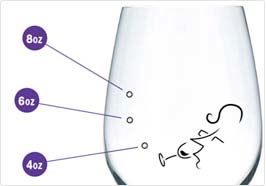 Big Sur Food & Wine Festival 2012 Not well publicized, but extremely well-loved by consumers and winemakers alike, this event will be held November 1-4, 2012. Participating wineries are a whose who of California Pinot Noir: August West, Calera, Cargasacchi, Copain, Fiddlehead Cellars, Flying Goat Cellars, Hahn Estates, Hirsch Vineyards, Hitching Post, Martinelli Winery Melville, Mirua, Morgan, Morning Dew Ranch, Paul Lato, Peay, Pelerin, Pisoni, Roar, Siduri, Skywalker Vineyards, Talbott, Talley Vineyards, Tantara, Testarossa, and Wind Gap - Wow! For tickets, visit www.bigsurfoodandwine.org.
 La Paulée de New York March 6-9, 2013 in New York City presented by Daniel Johnnes featuring the finest Domaines of Burgundy including Domaine Jean-Marc Bouley, Domaine Bruno Clair, Domaine Vincent Dauvissat, Maison Joseph Drouhin, Domaine Dujac, Domaine Fourrier, Domaine Lfarge, Domaine des Comtes Lafon, Domaine Leflaive, Domaine de la Romanee-Conti, Domaine Georges Roumier and more. Featured chefs for the Gala Dinner are Daniel Boulud of Restaurant Daniel, Daniel Humm of Eleven Madison Park, and Cesar RAmirez of Chef’s Table at Brooklyn Fare along with Michel Troisgros of Maison Troisgros in Roanne, France. For information, visit www.lapaulee.com. ¡Salud! Auction Packages Now Online The Dinner and Auction Gala will be held on Saturday, November 10, 2012, and includes an exciting range of live and silent auction packages. I have offered Lot 13, "The Russian River Valley Immersion Package four people." The package includes three nights at Benovia Winery Hideaway Cottage in Santa Rosa, four day tour of Russian River Valley wineries led personally by the Prince, including wineries such as Benovia, Rochioli, DuMOL, Twomey, Arista, Williams Selyem, Kosta Browne, and Thomas George Estates, gourmet lunches and dinners at the Russian River Valley's finest restaurants including great Pinots from the Prince's own cellar, one magnum each of Kosta Browne, Williams Selyem and Merry Edwards Russian River Valley Pinot Noir, and a $1,000 travel voucher for air transportation to Sonoma County or Bay Area. Last year the package raised $8,000. One luncheon will be with iconic Williams Selyem winemaker Burt Williams and will include a tasting of Burt's wines from the past and present (subject to his availability). Honestly, this is a one-of-a-kind trip with the money going to a gratifying cause. You can bid on the package without attending the ¡Salud! event by visiting www.saludauction.org and a dedicated attendant can be arranged to bid on your behalf. Better yet, attend the event in person to bid. Friday, November 9, is the Big Board Auction at Domaine Drouhin Oregon where the 2011 Oregon Pinot Noirs will be previewed. The Dinner Gala and Auction is on Saturday, November 10, at the Governor Hotel in Portland. ¡Salud! is one of the most long-lived and successful fundraisers, celebrating its 21st birthday. The program is supported by the Oregon wine community and Tuality Healthcare to provide access to healthcare services for Oregon's seasonal workers and their families. No other agricultural industry in the country supports its seasonal workers at this level. Workers normally move from crop to crop with no healthcare support. In 2011, over 3,600 workers and family members were registered in the program and over 7,000 medical and dental encounters were documented.
How to Love Wine
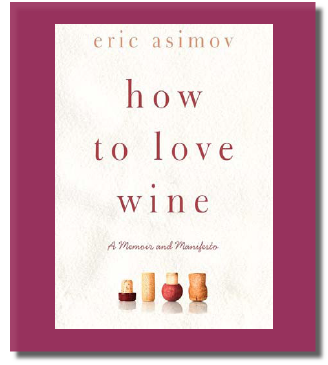 Eric Asimov has been the Chief Wine Critic for the New York Times since 2004. It is not a title he trumpets, for he is too unpretentious in nature to relish such an exalted anointment. The title, rather, is a figment of the Times’ imagination, intended to lend credence to the Times as an authoritative publication on wine. Regardless, Eric wears the title well, and is much beloved by those with an interest in wine. His weekly column appears in the Dining section of the Times. Since I am based on the West Coast and not a subscriber to the Times, I have not read Eric’s columns on a regular basis, and because I am so pinotcentric, I have only focused on his articles that feature my chosen grape. I had met Eric once, at the International Pinot Noir Celebration, where our contact was fleeting but sincere and respectfully gracious. It was natural that I was eager to read his first book on wine and learn more about him. As the subtitle of the book suggests, this is an autobiography, allowing the reader considerable insight into Eric’s upbringing, lifestyle, dreams, and loves, one of which is wine. We learn that he disdains the hoity-toity attitude of wine snobs (“Drinking wine is an elemental, natural pleasure that for too many people has been gilded with nonsense”), he abhors wine showmanship such as touting the talent of identifying a wine blind, dislikes blind mass tastings (he calls them “infantilizing”), is scornful of traditional tasting notes (referring to them as, “a useless, self-indulgent exercise”), and sees the 100-point wine scoring system as a necessary evil (“Scores for wine are not offensive....they simply don’t offer enough information to be useful”). The reader may be shocked that a wine critic could be so brutally honest in debunking common wine myths. People with even the slightest interest in wine are often fascinated by those lucky enough to earn a living writing about wine. Many of those so anointed remain very private, cautious about revealing too much of themselves less they threaten their “mystique.” In this book, Eric is completely open and confessional, and his personal life experiences are honestly portrayed so the reader understands how he traveled from point “A,” attending graduate school at the University of Texas where he had his wine epiphany, a bottle of 1978 Giacomo Conterno Barbara d’Alba, to point “B,” a man in his mid-fifties living in Manhattan who has an outlet for advocating his love of wine. Eric says, “This is the fundamental idea I want to convey....If you love wine, all the sense of fulfillment, pleasure, and satisfaction that you hope to get out of wine will follow.” This book is a good read, if only as a confirmation that Eric Asimov is a regular guy who never takes wine or himself too seriously. Ironically, he is not unlike wine itself, thoroughly embraceable. How to Love Wine: A Memoir and Manifesto, Eric Asimov, William Morrow (Harper Collins), 2012, hard cover, 277 pages, $24.99. Also available from HarperCollins e-books. |